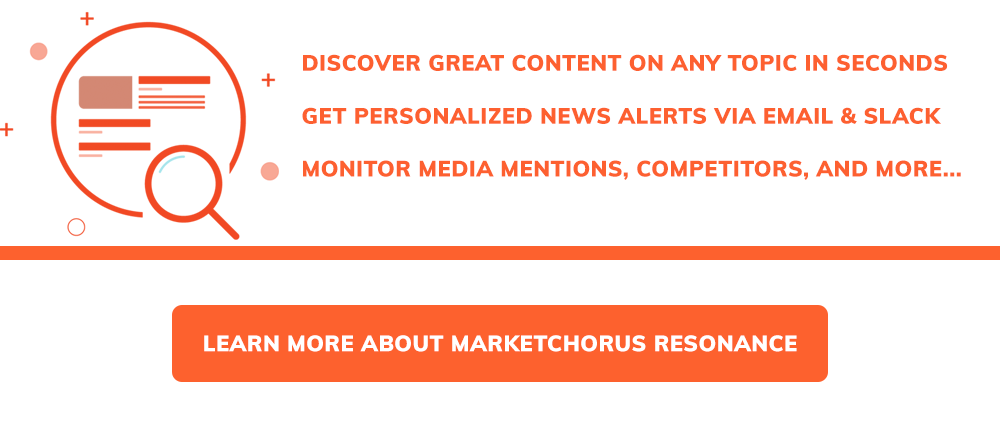Methods for promoting content have come full circle from the early days of blogging where you’d just reach out to your friends, send an email, or promote yourself at events.
Ironically those are best practices again today. However, in the intervening years, we used to rely on more automated and complex ways of attracting readers to our content.
Ironically, the channels for broad-market distribution of content are so full of noise and redundancy that our readers have had to take steps to decrease the noise they face. As a result a great deal of very useful content was the baby thrown out with the bathwater.
But mostly, we can blame our woes on losing our best promotional channels to their own hubris.
Google is great at finding popular websites, but is pretty terrible at discovering new and emergent information these days.
Social networks used to be reliable platforms for publishing and attracting new audiences, but these days you have to bring your own audience to the platform, leaving marketers wondering…what’s in it for us?
It feels like the only options left for building your audience are either ranking high in Google search for hundreds of “longtail searches” or building your audience one person at a time, at events, conferences, meetups, etc.
These methods are valid and should definitely be considered in your strategy, but they don’t scale and there will never be enough hours in the day to achieve your business goals through 1:1 promotion alone.
No…we need reliable one-to-many promotional strategies that we can learn once and repeat again and again.
Getting eyes on your content is a challenge we all face. We need automated, data-driven solutions for getting our message in front of the right people -and we need it now.
Introducing “Content Amplification”, the hero of our story
Content amplification, a formal process or system to leverage communities or platforms to distribute content at scale, is the industry’s answer to content promotion at scale. Brands have recognized the demand and a growing contingent of SaaS players are emerging to compete in this space.
Artificial intelligence will be a major differentiator on this battleground. With AI’s broad range of capabilities and its phenomenal speed and efficiency, the potential implications to content marketing are significant and far-reaching.
Suffice it to say, AI will radically change content marketing (for the better)…
As it relates to promoting and amplifying content, AI solutions are likely to dominate the market because of two factors.
First natural language processing (built on machine-learning algorithms) can digest and accurately derive meaning from huge amounts of text data faster than any human, but with a “human-like” degree of comprehension.
Second, distributed processing “in the cloud” allows AI algorithms to calculate data at volumes that no human or traditional software could approach in a similar timeframe.
Those two advantages virtually guarantees both that AI will dominate the content marketing industry and that anyone not using machine learning, either for building tools or marketing content, will be left in the dust.
None of us want that, so we’re left with only one option…
Integrate AI into everything we’re doing, just as fast as the technology becomes mainstream and accessible. Keep an eye out for AI technologies creating an impact in our industry and move quickly to adapt alongside our rapidly changing paradigm.
Since content promotion is a major source of frustration for marketers, we’d be right in assuming that there are data scientists and developers hard at work building machine-learning solutions to solve this problem.
We’d know, we’re one of those companies building AI solutions for content marketers and publishers. From our perspective here on the bleeding edge of marketing technology, this is a very exciting time to be a content creator.
And we’re coming full circle again, to a point where it will be absolutely necessary to rely on automation to manage the scale of our daily marketing activities. Yet we also know the up-and-coming generation craves more personalization and more 1:1 human contact in their business dealings.
AI will be the bridge that allows us to scale the repetitive, inhuman tasks we’ve spent the last few decades grinding out manually, day after day.
The robots be praised! They’re a ray of hope in the darkness of the average, overworked marketing professionals’ dreary task list. In the future, AI will help scale your promotional activities by automating redundancies and optimizing your activities based on evolving insights.
We can already get a glimpse of the future by looking at some of the pioneers in the space (yes, we’re including ourselves on this list!).
Here are 5 AI-powered blog amplification strategies you can implement today that don’t involve asking other content marketers for favors:

Programmatic Native Advertising
As I’m writing this article, a big merger was just announced between the two largest players in the native advertising game, Taboola and Outbrain. Now under the single brand, Taboola, the $2B+ native advertising giant is positioned to dominate a very important niche for content marketers.
There are fewer reliable channels for distributing content to engaged audiences than ever before, despite the astronomical size of online audiences these days. Taboola allows you to target fairly specific audience segments based on the content they consume and a mix of third-party demographic and behavioral data.
That’s a powerful combination of context and buyer insights that can be applied to your content amplification scheme. Click-through native platforms like Taboola allow you to promote your content as articles in the feeds of relevant popular websites…which already have engaged audiences.
Unlike your company blog which may be struggling to grow an audience of readers, major publishers have large audiences hungry for additional content.
Identify compelling stories to tell their audiences that are both magnetic and brand-adjacent and you have a turnkey traffic source for your content.
Let’s dig into those two terms a little deeper…
By magnetic I mean creating content that attracts a volume of readers with a winning combination of:
- A compelling headline that immediately conveys the value of your post
- A great opening that gets readers engaged right away
- A story that both entertains and educates the reader
- A call-to-action that resonates with a high percentage of readers
And if this can be done with visual content like a video, infographic, a series of GIFs, etc. all the better. When it comes to promoting through native, think bite-sized and shareable, and provide feel-good, immediate gratification content.
Remember, the goal is to hook your reader. You can move them to deeper in your funnel with other content once they’ve committed a few minutes to your content.
StackAdapt is another interesting player in the native advertising space, as they are more of a broker that pulls multiple native platforms together into a single dashboard where you can manage all of your campaigns.
One of the benefits of working with StackAdapt is that they have addressed all the formatting issues you’ll experience working with multiple publishers and platforms.
Their team works with each publisher, whitelisting the specific native ad positions which integrate seamlessly with content that meets StackAdapt creative specs. This feature is extremely useful when you’re working with native advertising campaigns at scale.

Content Curation Networks
Quuu Promote is leading the pack of content curation networks with a service that connects two markets in an ingenious way.
Content curation is a time-consuming activity that doesn’t translate into direct value typically. It’s a bit of a necessary evil, because curating content helps us stay in front of our audience more regularly without being solely self-serving.
But it’s not something that directly drives leads, increases conversions, or delivers revenue; so we only want to dedicate so much time to the activity.
On the other side of the situation you have content producers trying to get their content in front of new audiences and having to reach out to influencers one at a time to build a content amplification network.
Quuu sits between these two audiences, connecting those that need content to share with those who are producing content and need to promote it. For a nominal fee per piece of content, Quuu will recommend your content to curators in their network for 30 days. How well your campaign performs depends on how well you optimize your content for sharing.
To take full advantage of the platform and it’s thousands of content curators, be sure to optimize your content for sharing (and resharing) on social by following these best practices for sharing content with Quuu Promote.
Automated Link Building
Few activities can get you more website traffic in the long run, because of the importance of inbound links as a search ranking factor. Link building is a powerful tactic employed by all of the most successful digital marketers. It’s also a boring, time-consuming activity that is difficult to outsource.
So it’s perfect for AI…
MilkShake, a platform built on AI, automates outreach and follow-up emails for link building campaigns. Typically link building campaigns would require a person to manually send emails to dozens (or hundreds) of website owners, copying and modifying a script each time.
The platform optimizes email headlines, send times, and follow up workflows based on campaign performance, so that you can focus more time on creating content and discovering link opportunities.
Speaking of which…
Discovering link building opportunities in the first place is another boring, awful task that needn’t be so wasteful of your time. And now, thanks to a handy Chrome extension called CheckMyLinks, you can check any page you visit for broken links at a glance.
CheckMyLinks searches every page you visit for links and then verifies those links are valid, highlighting any broken links and notifying you. Quickly find the website administrator’s email address with Hunter and add them to your link building queue.
Link building is only effective at scale, so if you’re going to invest time into the activity you’ll need to maximize the number of people you’re contacting and minimizing the time you spend writing, editing, and analyzing your performance.
Since a good link opportunity can yield significant traffic returns, scaling your outreach could have an exponential effect on amplification. That’s the kind of one-to-many impact we need as marketers, to be able to growth hack our way to achieving our business goals.
Ad / Subject / Headline Optimization
Most of us have stared at our screens for longer than we’d like to admit to generate headline ideas. And our process for selecting the “best” one isn’t exactly predictive analytics…
Look, the robots aren’t coming after our jobs just yet, but, there are some things that AI does way better than humans. Optimization is one of those things.
Machine learning algorithms are fed a crazy amount of data to train them how to spot a “good” headline. Or to make the kind of recommendations that take the average headline and make it high performance.
Phrasee is an AI-powered copy optimization tool built for expressly this purpose. A monthly subscription provides headline recommendations, based on your business rules, for email, social media, and ads.
The platform assesses your content for meaning (using NLP) but also for sentiment and emotionality, and learns from your audience and your performance over time.
Headlines are auto-generated, tested and optimized programmatically; which increases efficiency, but also gives the operator time back in their day.

Tailored Social Media Audiences
A few years ago you could reasonably expect Facebook ads to provide you traffic for under $.50 per click that was of better than average quality.
That’s really not the case anymore. After Facebook removed the majority of their targeting options, the overall quality of traffic has declined while the costs per click have gone up in many cases.
Most marketers have already discovered the solution to this problem is using custom and website retargeting audiences but this just creates another set of problems.
If you can only target emails in your crm or website visitors, you’re not really getting in front of any new people. Retargeting is useful, of course, and you’d be crazy not to be retargeting across Facebook, LinkedIn, and even Twitter. But that doesn’t help you prospect for new audiences.
There aren’t a lot of great solutions to this particular problem right now, so here at MarketChorus, we’ve set out to find one.
We use natural language processing to understand the meaning of content shared on social networks (web pages, blog posts, videos, you name it) and then build audiences of people who are engaging with that content and related content.

Our platform, MarketChorus Resonance, works like this:
- Search any term you want to know more about. We’ll return a list of recent articles and related topics on the subject.
- Filter out topics you don’t want to see and dig deeper into what’s emergent and interesting to you. Our algorithm matches to increasingly more relevant content as you work.
- When find something worth writing about, save that search in Resonance, you’ll have a ton of relevant content at your fingertips so you can quickly understand the topic and spot the gaps in coverage.
- Do your thing. Produce high quality content on your chosen topic.
- As you’ve been refining your search, Resonance has been tracking all the social media activity for the search you saved. Anyone sharing, liking, commenting on, or retweeting them on Twitter is saved to a list you can retarget with Promoted Tweets and export for use in other tools.
- Resonance also identifies any influencers that are engaging with this content that have sizable audiences and high levels of engagement. These profiles can be retargeted and exported separately.
- Reach these audiences on Facebook or through Google Ad Network by mapping the related topics we discovered from your saved search to longtail Facebook Interests and keywords. For convenience, Resonance builds saved audiences directly in your Facebook Advertiser account.
At MarketChorus we think of content amplification as the 4th step in the 5 part process that we call the “content lifecycle”.
AI tools like Resonance support the content lifecycle (and the marketers that manage it) by automating repetitive tasks, providing recommendations, and optimizing your process in the background.
We believe there’s a flywheel effect that can be harnessed within content amplification. It’s not that people don’t want to read your content. They just can’t find it.
Tools to get your story in front of the right audience add momentum as each new reader consumes, engages, and shares your work to their networks.
Once the flywheel is turning, the momentum builds, and more and more people see and share your content. In turn your website traffic grows and you convert more leads, connecting your investment in content marketing to business outcomes.
We’re passionate about making this dream a reality, as are the teams behind the other tools we mentioned in this post. It’s an exciting time to be a marketer. Take advantage and integrate AI into your content marketing strategy in 2020 and beyond.




